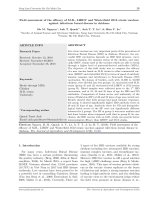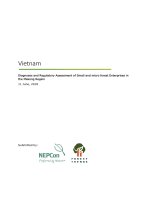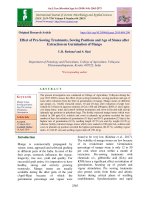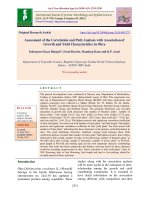Allelopathic potential assessment of sorghum and sunflower on germination characteristics of Phalaris minor and wheat
Bạn đang xem bản rút gọn của tài liệu. Xem và tải ngay bản đầy đủ của tài liệu tại đây (235.09 KB, 5 trang )
Int.J.Curr.Microbiol.App.Sci (2019) 8(10): 256-260
International Journal of Current Microbiology and Applied Sciences
ISSN: 2319-7706 Volume 8 Number 10 (2019)
Journal homepage:
Original Research Article
/>
Allelopathic Potential Assessment of Sorghum and Sunflower on
Germination Characteristics of Phalaris minor and Wheat
Arya Kumar Sarvadamana*, V. Pratap Singh, S. K. Guru, S. P. Singh,
Tej Pratap, Sirazuddin and Suprava Nath
Department of Agronomy, G. B. Pant University of Agriculture & Technology,
Pantnagar, India
*Corresponding author
ABSTRACT
Keywords
Aqueous extract,
Allelopathy,
Germination
percent, Sorghum,
sunflower
Article Info
Accepted:
04 September 2019
Available Online:
10 October 2019
A laboratory experiment was conducted to assess the allelopathic effect of
aqueous extracts of sorghum and sunflower on germinating seedlings of
Phalaris minor and wheat. 10% (w/v) aqueous extracts of sorghum and
sunflower were applied on the seed of Phalaris minor and wheat and the
parameters like germination percent, relative germination ratio, speed of
germination, mean germination time, days to 50% germination were
calculated. In all the calculated parameters it was found that the aqueous
extracts of both sorghum and sunflower are highly allelopathic to Phalaris
minor and they have a very little effect on wheat. Both sorghum and
sunflower aqueous extracts significantly reduced the germination of
Phalaris minor as compared to control (distilled water), but sunflower was
more allelopathic than sorghum with 85.5% of germination inhibition.
Introduction
Wheat is the most important cereal crop of the
world and the second most important in India
having 30.17 million hectare area and 99.70
million tonnes of production (Anonymous,
2018). It has a lion share of. about 35% in
national food basket. Wheat is a very rich
source of nutrients, which have 76%
carbohydrate, 1.5% fat and 13% protein.
Albumins, globulins are the major proteins of
the gluten complex. The contents of minerals
and of dietary fibers are very low; 0.5% and
1.5%, respectively (Belderok et al., 2000).
Rice-wheat cropping system is the most
dominant cropping system of India. In RiceWheat cropping system along with other
traditional weed flora Phalaris minor became a
major problem causing drastic reduction in wheat
yield (Chhokar et al., 2006). Wheat fields in
Northern India are badly infested with wide range
of grassy and non grassy weeds in general and
Phalaris minor Retz. in particular. Continuous
application of herbicides at suboptimal dose,
256
Int.J.Curr.Microbiol.App.Sci (2019) 8(10): 256-260
Phalaris minor gradually developed resistance
against these (Chhokar and Malik, 2002). Hence,
to tackle this problem alternative weed control
methods like allelopathic approach can be a
potential tool in future.
properly with chromic acid to remove all the
dirt adhering with it. Then it was washed with
distilled water and put in hot air oven for
drying. After the drying is completed the
petridishes were sterilized with methanol.
Materials and Methods
On the bottom side of petridish two filter
papers were put to hold the aqueous extract.
Then 50 seeds were arranged uniformly on the
filter paper and 5ml aqueous extract was
added to each petridish with help of pipette.
The laboratory experiment was conducted in
seed physiology laboratory, Department of
Agronomy, Collage of Agriculture, Govind
Ballabh Pant University of Agriculture and
Technology, Pantnagar, Udham Singh Nagar,
Uttarakhand. Sorghum and sunflower biomass
was collected from the Norman E. Borlaug
Crop Research Centre, Govind Ballabh Pant
University of Agriculture and Technology,
Pantnagar and were shade dried for about one
week at Weed management block (D2). Then
the biomass of sorghum and sunflower shade
dried at 65±5 ºC for 72 hours and finely
ground with an electric grinder after fully
drying. The grinded biomass was placed in an
air tight container in cool and dry place. The
ground biomass was weighed using high
precision electronic balance. After this the
grinded biomass was well mixed in distilled
water and soaked for 48 hours in refrigerator
to avoid fermentation. This was then filtered
using muslin cloth to get aqueous extract.
Using this method aqueous extracts of
sorghum and sunflower of 10% concentration
(w/v, dry weight basis) was prepared.
The experiment was carried out in Completely
Randomized Design (CRD), with three
treatments i.e. control (distilled water), 10%
aqueous extract of sorghum, 10% aqueous
extract of sunflower, each with three
replications.
Healthy, disease free and uniform seeds of
both wheat (variety-DBW 17) and Phalaris
minor were collected and treated with thiram
to avoid fungal infection. Petridishes with
15cm diameter was also taken and cleaned
Finally the pertidishes were put in a seed
incubator at 25±1 ºC for 7 days for the
germination procedure to be completed.
The parameters were calculated as the formula
given belowGermination percent (AOSA, 1998)
=
× 100
Relative germination
Kill,1986)
=
ratio
(Rho
and
× 100
Speed of germination (AOSA,1983)
=
+ ------- +
Where,
n= number of seeds newly germinated on day
di
di= ith day after incubation
Days to 50% germination (Dezfuli et al.,2008)
257
Int.J.Curr.Microbiol.App.Sci (2019) 8(10): 256-260
by fulfilling our aim. Hence, sunflower aqueous
extract can be used as a potential tool for Phalaris
minor control in wheat.
Where,
ni and nj are cumulative number of seeds
germinated by adjacent counts at times ti and
tj, where ni˂N/2˂nj
Based on this findings a field experiment was
also conducted by the sequential (pre fb early
post) application of both the aqueous extracts of
sorghum and sunflower at same concentration
(10%).
Results and Discussion
Relative germination ratio
N= final number of germinated seeds
Germination
incubation)
per
cent
(7
days
after
The germination per cent of wheat was found
non significant between the treatments, which
is a desirable character. But, numerically
maximum germination percent was found in
case of control and extract of sunflower
(96.00%). However, minimum (94.0%) was
achieved by the application of extract of
sorghum at 10 % (Table 1).
The germination per cent Phalaris minor was
found highest in control (82.66%). In case of
aqueous extract of sunflower lowest
germination percent of Phalaris minor was
found (12%), which is significantly lower than
both control and aqueous extract of sorghum
at same concentration. The application of
aqueous extract at 10 percent concentration
reduced the population of Phalaris minor by
85.4% and 42.7% under sunflower and
sorghum extracts respectively with respect to
control.
It is evident that sorghum and sunflower
extracts have strong allelopathic effect on
Phalaris minor but little allelopathic effect on
wheat. It also matches with the findings of
Anjum and Bajwa (2005).
Among sorghum and sunflower, sunflower has
higher inhibitory effect on Phalaris minor and it
also does not affect germination of wheat, there
Relative germination ratio gives information
about germination percent of all the treatments
in comparison to control. In wheat relative
germination ratio was found non-significant
among the treatments.
It shows that all the treatments are alike with
respect to their percentage of germination.
This gives an idea that the allelochemicals
present in sorghum and sunflower don’t check
germination of wheat seeds. But, while the
Phalaris minor seeds lowest germination ratio
was obtained with aqueous extract of
sunflower treated seeds (14.5) followed by
aqueous extract of sorghum treated seeds
(57.16).
This type of result comes due to a little
allelopathic effect of sorghum and sunflower
on wheat and a very high allelopathic effect on
Phalaris minor seeds. This type of result
matches with the study of Bhadoria, (2011).
Speed of germination
The aqueous extract of sorghum as well as
sunflower had no effect on the speed of
germination f wheat.
However, in case of Phalaris minor the
minimum speed was recorded with application
of aqueous extract of sunflower (10%), which
was significantly lower than the aqueous
extract of sorghum (10%) (Table 2).
258
Int.J.Curr.Microbiol.App.Sci (2019) 8(10): 256-260
Table.1 Effect of aqueous extracts of sorghum and sunflower (10%) on germination percent and
relative germination ratio of wheat and Phalaris minor
Treatment
Control
(distilled water)
Sorghum (10%)
Sunflower
(10%)
SEm±
CD (5%)
Germination percent (%)
Wheat
Phalaris minor
96.00
82.66
Relative germination ratio
Wheat
Phalaris minor
100
100
94.00
96.00
47.33
12.00
97.74
99.55
57.16
14.5
0.94
NS
1.30
4.50
1.50
NS
1.35
4.77
Table.2 Effect of aqueous extracts of sorghum and sunflower (10%) on Speed of germination,
Mean germination time and Days to 50% germination of wheat and Phalaris minor
Treatment
Control
(distilled
water)
Sorghum
(10%)
Sunflower
(10%)
SEm±
CD (5%)
Speed of germination (no.of
seedlings germinated/ day)
Wheat
Phalaris
minor
6.9
5.9
Mean germination
time (days)
Wheat
Phalaris
minor
5.34
3.36
Days
to
50%
germination
Wheat
Phalaris
minor
3.12
4.25
6.73
3.38
5.22
1.89
3.17
4.31
6.83
1.57
5.47
0.54
3.13
4.29
0.06
NS
0.08
0.30
0.05
0.18
0.02
0.08
0.04
NS
0.07
NS
While both the aqueous extracts
significantly superior over control.
were
It is obvious that aqueous extract of sunflower
(10%) has a inhibitory effect on the
germination of Phalaris minor.
This finding are in agreement with the reports
of Ghafar et al., (2001), who stated that five
allelochemicals like (chlorogenic, caffeic,
syringic, vanillic and ferulic acid) in leaves,
three allelochemicals in stem (chlorogenic,
ferulic and vanillic acids) and only one
(ferulic acid) in the roots have allelopathic
effect on Phalaris minor.
Mean germination time
The mean germination time of wheat in
aqueous extract of sunflower 10% (5.47) is
statistically at par with control (5.34), however
it was significantly higher than aqueous
extract of sorghum 10% (5.22). The mean
germination time of Phalaris minor was found
significantly lower by the application of both
the aqueous extract of sorghum (1.89) and
sunflower (0.54) than control (3.36).
This results reveals that sunflower has a lesser
inhibitory effect on wheat followed by
sorghum extract, and a very strong
259
Int.J.Curr.Microbiol.App.Sci (2019) 8(10): 256-260
allelopathic effect on Phalaris minor. Hence,
it may be concluded that sunflower can be a
potential source in managing Phalaris minor
in wheat crop.
Days to 50% germination (T50)
Days to 50% germination was found non
significant over the treatments on both wheat
and Phalaris minor. But numerically it was
found higher in aqueous extract of sorghum
10% (4.31) on Phalaris minor. This might be
due to the allelo-chemicals affect the
germination process uniformly throughout the
germination period.
References
Anjum, T. and Bajwa, R. 2005 A bioactive
annuionone from sunflower leaves.
Phytochem 66: 1919–1921.
Anonymous. 2018. Agricultural Statistics at a
Glance-2016.Directorate of Economics
and Statistics, Ministry of Agriculture,
Govt. Of India.
Association of Official Seed Analysis (AOSA)
1983.Seed vigor testing handbook,
Contribution No. 32 to the Handbook
of seed testing.
Association of Official Seed Analysis (AOSA)
1998.Rules of testing seeds. Journal of
Seed Technology. 12: 1-112.
Belderok, B.; Mesdag, H. and Donner, D.A.
2000. Bread-Making Quality of Wheat.
Springer, New York.
Bonner, F.T. 1983. Germination responses of
loblolly pine to temperature differences
on a two-day thermogradient plate. J.
Seed Technol., 8(1): 6-14.
Chhokar, R.S. and Malik, R.K. 2002.
Isoproturon resistant Phalaris minor
and its response to alternate herbicides.
Weed Technology. 16: 116-123.
Chhokar, R.S.; Sharma, R.K.; Chauhan, D.S.
and Mongia, A.D. 2006. Evaluation of
herbicides against Phalaris minor in
wheat in north western plains. Weed
Research. 46: 40-49.
Dezfuli, P.M.; Sharif-zadeh, F. and
Janmohannadi, M. 2008. Influence of
priming
techniques
on
seed
germination behavior of maize inbreed
lines (Zea mays L.) ARPN Journal of
Agriculture and Biological Science,
3(3): 22-25.
Ghafar.A; Saleem.B.; Haq.A. andQureshi,
M.J. 2001.Isolation and identification
of allelochemicals of sunflower
(Helianthus annuus L.). Int J Agric.
Biol., 3: 21–22.
Rho, B.J. and Kill, B.S. 1986. Influence of
phytotoxin from Pinusrigida on the
selected plants. Journal of Natural
Science. Wankwang university. 5:1927.
How to cite this article:
Arya kumar Sarvadamana, V. Pratap Singh, S. K. Guru, S. P. Singh, Tej Pratap, Sirazuddin and
Suprava Nath. 2019. Allelopathic potential assessment of sorghum and sunflower on
germination characteristics of Phalaris minor and wheat. Int.J.Curr.Microbiol.App.Sci. 8(10):
256-260. doi: />
260









